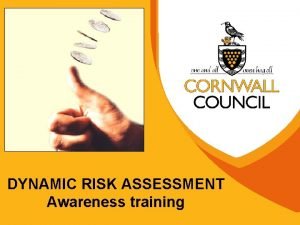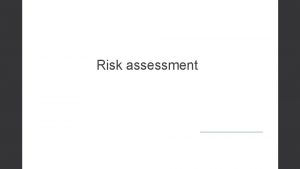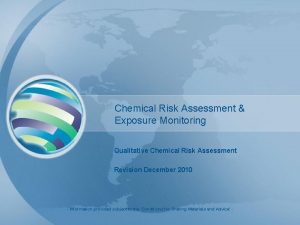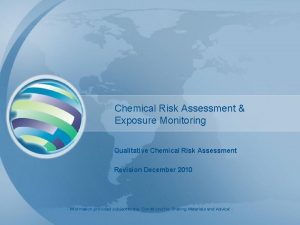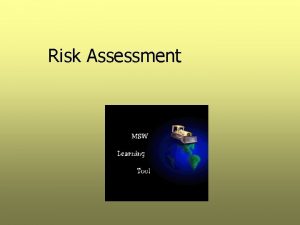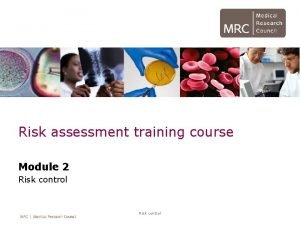Twoday training course on Chemical Risk Assessment for












- Slides: 12

Two-day training course on: Chemical Risk Assessment for the Environment. Day 1. Adam Peters and Graham Merrington 2017 1

§ Introductions § Course format and expectations » Day 1 § § § Aims and objectives The risk assessment paradigm The never ending journey – PECs/PNECs Protection goals Regulatory Drivers 2017 2

Introductions § Adam Peters…. » » Post doc Environment Agency SEPA wca § Graham Merrington…. . » » Post doc Lecturer – B’mouth, Adelaide Environment Agency wca 2017 3

Course format and expectations § § § Slides - booklet Tests Discussions Exercises……(excel sheet of datasets) Questions and perhaps, some answers? ! Resources – wca-environment. com Or? 2016 4

Aims and Objectives § Good practice in chemical risk assessment § Behaviour, fate, hazards of chemicals § Where in the environment? § Regulatory context (who cares? ) § If I can’t do it, where can I find the information I need? ! § Avoiding the major pitfalls! § Getting a start (not a finish) 2016 5

The risk assessment paradigm § Firstly, get a nice complicated, interminable diagram § Then spend a lifetime trying to work out what it means § Quote endlessly from the diagram…. . § When asked about what it means, suck air through teeth, shake head from side to side and say “well, I’m afraid it is very complicated. § Or, you could try and keep it simple? 2016 6

The risk assessment paradigm § Model or measure chemical in environment (this is the exposure) § Compare this to the environmental hazards of the chemical (this is the effects) § Characterise the risk…. Exposure concentration/effect concentration § Refine…. (get better exposure or effects data) 2017 7

The never ending journey? § Refinements…. . iterate. § Effort invested commensurate with level of assessment: » Screening, quick, precautionary but often quite uncertain » Specific, more time, better data, less precautionary, more certain (scales!) § Exposure: Predicted Environmental Concentrations (PEC) or Measured Environmental Concentrations (MEC) § Effects: Predicted No Effect Concentrations (PNEC) More ecotox data (Nickel? ), higher-tier data, understand mode of action? 2017 8

Protection goals and points of protection § Often defined (badly or not at all) in legislation POINT OF PRODUCTION controls on raw materials, processes POINT OF EMISSION Most chemical standards apply here but may be translated into controls at point of emission limits on emissions e. g. discharge permits POINT OF CONTACT limits in ambient environment INTERNAL DOSE limits on body burdens 2017 9

Regulatory drivers § Many regulatory drivers require assessment of potential chemical risks » REACH » Human and Vet meds (although no notice is taken of ERA for human meds) » Biocides » Plant Protection Products » Cosmetics » Wastes and Sewage Sludges » Industrial Emissions Directive? § Important to note, an Environmental Quality Standard (EQS) is NOT a PNEC. Why? 2017 10

Questions………. . § Is there any difference between hazard and risk…? § In the environment, ecosystems are exposed to mixtures of chemicals. Why do we not regulate for this? § When you’ve done an assessment, how do you know it is right? § Will we be covering any human health related issues? 2017 11

2016 12
 Market risk assessment
Market risk assessment Risk management awareness training
Risk management awareness training Cut brick lengthwise
Cut brick lengthwise Course number and title
Course number and title Course interne course externe
Course interne course externe Certification course in risk management nibm
Certification course in risk management nibm Financial risk management syllabus
Financial risk management syllabus Fspos vägledning för kontinuitetshantering
Fspos vägledning för kontinuitetshantering Typiska novell drag
Typiska novell drag Tack för att ni lyssnade bild
Tack för att ni lyssnade bild Ekologiskt fotavtryck
Ekologiskt fotavtryck Shingelfrisyren
Shingelfrisyren En lathund för arbete med kontinuitetshantering
En lathund för arbete med kontinuitetshantering

